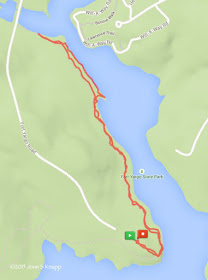August 25th. (Continued from…). I started to walk again
at Fort Yargo State Park in Winder, Georgia. One of my favorite walks is from
the Group Shelter A to the Old Fort and back.This
is a rewarding walk for viewing wildflowers and I’ve This is a rewarding
walk for viewing wildflowers and I’ve been walking it every week and documenting
the wildflowers that I see.
The early spring wildflowers have finished blooming; it’s time to
watch the developing fruit. Summer wildflowers were still blooming but it was
time to turn attention to the fungi in the woods.
Just before I reached the first bridge on this trail, I found another cluster of ‘Honeycomb’ Coral Slime (Ceratiomyxa fruticulosa var. porioides) on the log on which I had first found them. These were developing and it’s easier to appreciate their structure.
A Red-spotted Purple (Limenitis
arthemis) butterfly was enjoying the sunshine on the bridge.
The seed capsules were still developing on the Pipsissewa (Chimaphila maculata) just past the
bridge.
Further along the trail, the seed capsules on the Eastern
Sweetshrub (Calycanthus floridus) was
completely ripe. These capsules may remain attached to the plant into the
winter. It will be interesting to see how long this capsule hangs on.
The seeds in the Wild Yam (Dioscorea villosa) were visible though the seed capsule but they
weren’t ripe.
The seed capsules on the witchhazel (Hamamelis sp.) were unchanged; the…
flower buds were also unchanged, as were the…
seed capsules on the Mountain Azalea (Rhododendron canescens).
The second Eastern Sweetshrub fruit had turned brown finally.
A surprising sight. A Dog’s Vomit slime mold (Fuligo septica) plasmodium had been in
the process of moving across the top of an old stump and had mostly formed the
fruiting structures. The trailing end (on the right-hand side) was still in the
plasmodial stage. (Unfortunately, the tail end of the plasmodium didn’t form
fruiting structures; I think it dried before it could do so.)
I found some Chocolate Tube (Stemonitis sp.) slime mold fruiting bodies on the side of the stump
near the ground. (I rotated the image for easier viewing)>
Between the cliff and the Fishing Area, I found another
Shaggy Stalked Bolete (Heimioporus betula).
The cap on this one was a more characteristic red color that still had some of
the glossy sheen that would be uniform on the cap in a younger specimen. The
red color under the shaggy surface on the stem is much more apparent than it
had been on the specimen I had found near the beginning of the trail.
I was treated to yet another Red-spotted Purple butterfly
before I reached the Fishing Area.
The fruit
on the Buttonbush (Cephalanthus
occidentalis) were unchanged from the previous week. I wondered how long it
would take for these to mature.
Some Bushy Seedbox (Ludwigia
alternifolia) were blooming and producing fruit at the edge of the shallow
water in the Fishing Area.
At the north end of the Fishing Area, mushrooms were starting to
grow. I couldn’t identify these this year; they are probably a Hypholoma sp. Perhaps, next year, I’ll
be able to identify the species.
Nearby, a couple of Leucocoprinus
cepastipes were fruiting.
From here, I headed to the ‘Rock Garden.’
(To be continued…)
References:
- Mushroom
Expert. Kuo, M. Heimioporus betula
- Mushroom
Expert. Kuo, M. Leucocoprinus cepastipes























No comments:
Post a Comment